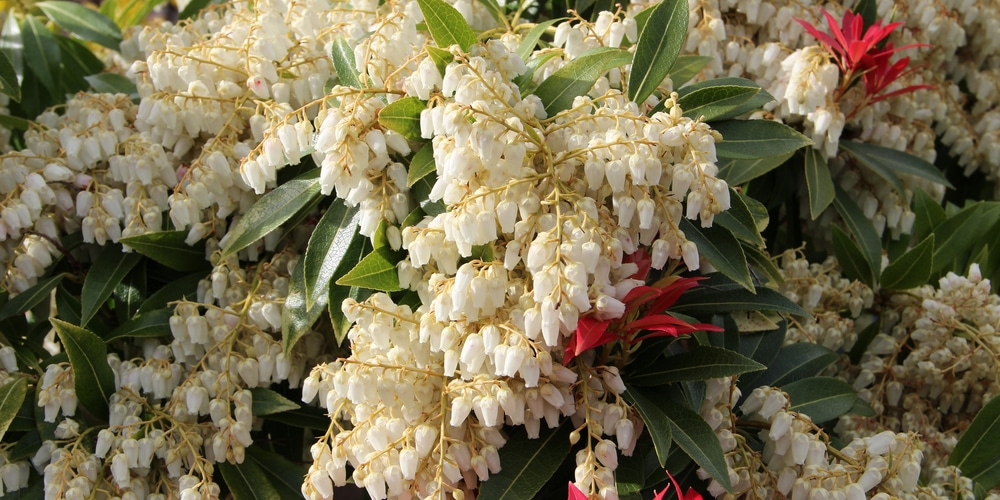A beautiful hybrid of the A. grandiflora and A. schumannii, the Abelia Edward Goucher is named after its grower, Edward Goucher. The plant has a signature flower and companion calyx that’s sure to delight viewers.
| Botanical Name | Abelia x Edward Goucher |
| Common Name | Edward Goucher Abelia |
| Plant Type | Perennial |
| Flower Color | Funnel-shaped blooms with lilac and pink hues |
| Size When Mature | 60 inches |
| Bloom Time | Mid-summer until fall |
| Sun Requirements | Full sun to partial shade |
| USDA Hardiness Zones | 6 to 9 |
| Soil PH Range | Alkaline, Acidic, Neutral |
| Soil Type | Well-draining |
| Water Needs | Medium |
| Native Area | Mexico and East Asia |
What you Need to Know About Abelia Edward Goucher
Introduced by Goucher of the USDA in 1911, the plant quickly gained acclaim due to its superb pink and lilac blooms accentuated by bronze calyx lobes. The semi-evergreen shrub sports glossy leaves that have a bronze tinge that fades over time, and the magnificent pink and lilac blooms start opening from mid-summer through fall.
How to Care for Abelia Edward Goucher
Here’s everything you need to know about growing and caring for a thriving Abelia plant.
Light
Abelia Edward Goucher loves to bask in full sunlight and produces the best blooms when exposed to such an environment. However, those who live in warmer regions, e.g., in zones 9 or 10 will want to see first if their plants can tolerate the heat of the blazing sun or not. Otherwise, it’s best to position the Abelia x Edward Goucher in partial shade where it gets 2 to 3 hours of sunlight in the morning and shade throughout the day.
This Abelia species works well as a hedge or border, as well as in a suitably-sized container. You can put the Abelia Edward Goucher indoors as long as it gets a window with bright light.
Water and Soil Needs
‘Edward Goucher’ Abelia can grow in a wide range of soil types, including loam or sand, but it needs a well-drained medium to thrive.
As far as pH is concerned Abelias won’t mind if you put them in alkaline, acidic, or neutral soil. For the best results, grow in a well-drained garden or potting mix with plenty of organic material.
Temperature Requirements
Abelia ‘Edward Goucher’ can grow in USDA zones 6 through 9. Depending on the climate, the perennial shrub will either act as a semi-evergreen (in warmer regions) or a deciduous (where winters are cold).
While dormant, the ‘Edward Goucher’ plant can survive frosts at minus 10 degrees F.
Fertilizer
The best fertilizer to use on an Abelia ‘Edward Goucher’ is slow-release nitrogen fertilizer. A well-balanced fertilizer mix with equal parts nitrogen-phosphorus-potassium also works well.
Ed Goucher Abelia responds quite well to a spring feeding of slow-release nitrogen fertilizer. This can be done yearly or when your shrub is looking dull and doesn’t produce as many flowers as before.
Common Diseases
Not a lot of pests or diseases affect the Edward Goucher Glossy Abelia, and it’s drought and deer resistant as well. However, there might be the occasional infestation of aphids, which can be easily resolved with a commercial product or a DIY mix made from common household items.
You can control aphids by dislodging them from leaves with jets of water and putting them in soapy water. You can use organic sprays such as neem oil as a preventive measure. Aside from removing aphids by hand on sight, you can occasionally spray your Abelia with a mixture of dishwashing soap and water.
Abelia Edward Goucher Propagation
Abelias can be propagated using stem cuttings in summer. After pruning in the spring, you can choose healthy softwood samples that have around two to three sets of leaf nodes. Remove the leaves on the lower parts and prepare a garden mix that’s well-drained.
Stick the ‘Edward Goucher’ Abelia cuttings and submerge the first set of nodes in the medium. Spray or water the soil until it’s moist but not overly wet, then leave the container in a location that gets shaded, bright light.
In several weeks, you should be able to see new growth on the stems. Repot or transplant outdoors if the roots have grown to around 2 to 4 inches long.
You May Also Like: Purple Indoor plants to Brighten Your Home

